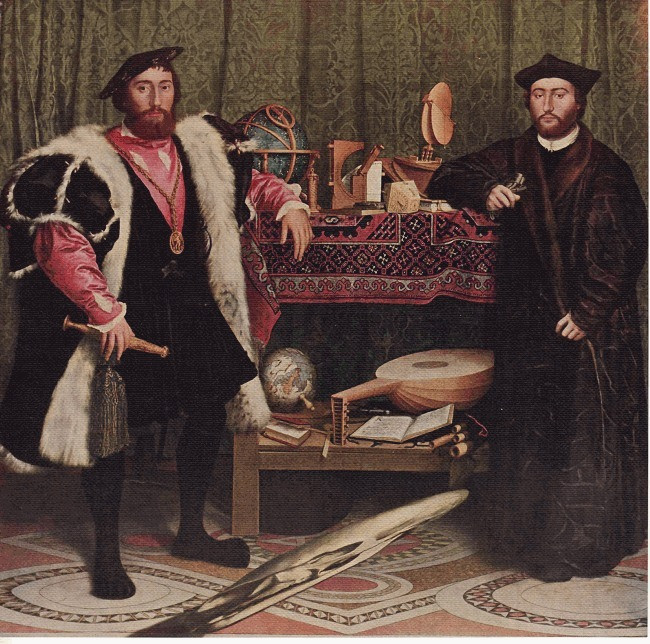HOME | DD
 Touch-Not-This-Cat — The Ambasadors, a comparative1
Touch-Not-This-Cat — The Ambasadors, a comparative1

Published: 2007-06-17 01:16:13 +0000 UTC; Views: 1547; Favourites: 19; Downloads: 12
Redirect to original
Description
The AmbassadorsBy Hans Holbein the Younger (1497-1543)
In the National Gallery, Liverpool
It is not possible to review fully the many conjectures which have been made concerning this celebrated painting - the identities of the ambassadors, the meanings of the various objects which are displayed, or the explanation for the curious fish-like object seen on the floor, which was discovered to be a skull drawn in unusual perspective. The marvel of it lies in the striking portraits, which dominate the picture in spite of the wealth of accessories which are so minutely depicted.
The two men stand in most conventional attitudes at each end of a desk, looking for all the world as if they were having their photographs taken and were determined not to move a muscle. The figures are short in proportion to the sizes of the heads, and the composition is almost aggravatingly symmetrical. These are the defects of the picture, and though they strike the beholder at once, the work is so masterly that the impression of its strength, particularly the faces of the two men, remains in the mind long after it has been viewed.
The background is hung with green damask, in the upper left-hand corner of which is seen a silver crucifix. The upper shelf of the stand between the two men is covered with a Turkish rug, exquisitely painted, upon which are placed a number of mathematical and astronomical instruments, and a celestial globe. On the lower shelf are similar objects, and also a lute, the broken string of which will not escape the spectator.
The fine mosaic of the floor is to be noted, as it is an accurate copy of the well-known pavement in the Sanctuary of Westminster, and reminds us that the picture belongs to the period of the painter's sojourn in England, when he was in the service of King Henry VIII.
From the book "Famous Paintings" printed in 1913. Descriptive notes by G.K. Chesterton
I acquired this excellent piece for this comparative study from this beautiful website:
[link]
We will start with the unaltered original for discussions as to meaning an purpose. I feel there is not enough such analysis by too many modern artists.
Related content
Comments: 6

👍: 0 ⏩: 1

Huh! That’s the first I heard of that, but it makes sense.
👍: 0 ⏩: 0

lol, this brings back fond memories of cramming for the awful Art History course exam XD
👍: 0 ⏩: 1

Oh phoo, is someone like Chesterton had been teaching, you would have been beging for more.
👍: 0 ⏩: 1

👍: 0 ⏩: 1

HAH! YES!
“For the Irish are a people that the Good Lord Made mad!
For all their wars are merry, and all their songs are Sad!”
youtu.be/cpZALHLB6HA
👍: 0 ⏩: 0























